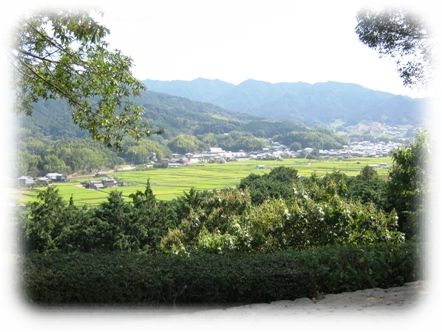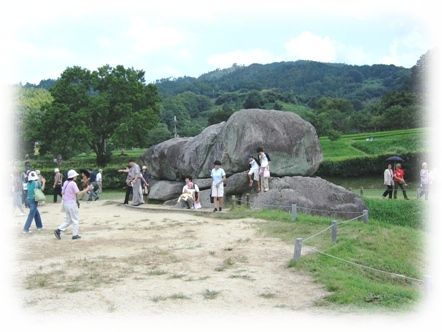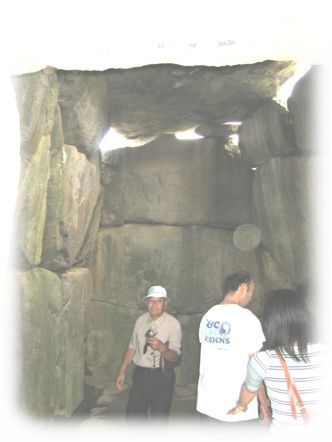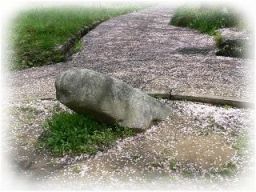Ancient Stonework - Asuka Village, Japan [Outing]
This is the ishi-butai ancient tomb in Asuka Village, Nara, Japan. It was said that this is a local ruling family’s tomb - according to one explanation, Umako Soga's one. In Asuka village, there are many mystery stones, and the archaeological researcher executes the investigation. Also, here was a place where the first capital of Japan was established in A.D. 643. When I actually went to here, I could find a many mysterious gigantic stones. If we see them at first glance, there are some stones we cannot figure out for what it was intended.





Asuka's Ancient Stones
English Map;
http://www.mapfan.com/en/en_m.cgi?MAP=E135.49.44.2N34.27.48.6&ZM=11
Information;
Asuka Village’s HP
http://www.asukamura.jp/english/index.html
The Museum, Archaeological Institute of Kahsihara
http://www.kashikoken.jp/museum/gaikokugo/english/index-eng.html
National Institute for Cultural Heritage, Nara National Research Institute for Cultural Properties
http://www.nabunken.go.jp/english/index.html
Rekishi Kaido by KIIS (Kansai Institute of Information Systems)
http://www.kiis.or.jp/rekishi/asuka/asuka_asuka-e.html
Japan Traveler Online
http://japantraveleronline.com/
Nara Prefectural Government
http://www.pref.nara.jp/english/
Kintestu Lines
http://www.kintetsu.co.jp/foreign/english/index.html
Tender Green - Strolling in Asuka Village, Japan
http://ease-loving.blog.so-net.ne.jp/2009-04-29
How to Get There;
At “JR Tokyo Station”, get on shin-kan-sen super express for 2 hours and 21 minutes to “Kyoto”, and change trains to get to the Kintestu express bound for “Kashihara-jingu-mae”, and change again to the local lines. Then, get off at “Asuka Station” - Total about 3 hour and 50 minutes.
At “Kansai Airport”, get on Nankai Express bound for “Namba” for 37 minutes. Get on Kintetsu Lines from “Kintestu Namba Station” to “Yamato Yagi”, and change trains to get to the local lines. Then, get off at “Asuka Station” - Total about 2 hours.
At “Kansai Airport”, get on JR rapid express to “Ten-no-ji” for 49 minutes, and walk 5 minutes to “Osaka Abeno Bashi Station” to get to the “Kintestu Minami Osaka Lines”. Get on express bound for “Kashihara-jingo-mae”, and then change lines to get to the local lines and get off at “Asuka Station” - Total about 1 hour and 50 minutes.
<古代の石造物 - 明日香村>
明日香村にある石舞台古墳です。古代の豪族の墓(一説に蘇我馬子の墓)とも言われています。明日香には、いろいろな不思議な石があり、考古学的な研究もされています。日本に最初の都(A.D. 643)ができたのもこのあたりです。実際に行ってみると、不思議な巨石がたくさんあります。この石舞台は、石室があり、墓であろうということがわかるのですが、中には一見、製作意図のわからない石造物もあります。
近鉄「飛鳥」駅前にはレンタサイクル店が何件かあります。遺跡や資料館をめぐってのサイクリングがお勧めです。地図のオレンジ色の線がサイクリングロードです。晴れた日にはお弁当持参でサイクリングが満喫できることでしょう。村には自然が多く、映画の「となりのトトロ」に出てくる風景を想像していただければイメージに合う村です。
石舞台の玄室の中はひんやりしていて、想像以上に天井が高いです。わーとかいうと、こだまします。子供は喜ぶでしょうね。近くには、岡寺や聖徳太子の橘寺、高松塚古墳、キトラ古墳などもあり、見どころいっぱいです。興味のある方はぜひ奈良、明日香村へ。お勧めです。
飛鳥の古代の石群
<地図>
<関連情報>
「明日香村」
http://www.asukamura.jp/kanko.html
「橿原考古学博物館」
http://www.kashikoken.jp/index.html
「奈良国立文化財研究所」
http://www.nabunken.go.jp/index.html
「歴史街道」
http://www.kiis.or.jp/rekishi/kaido.html
「Japan Traveler Online」
http://japantraveleronline.com/
「奈良県庁」
http://www.pref.nara.jp/dd_aspx_menuid-1250.htm
「近畿日本鉄道」
http://www.kintetsu.co.jp/
「新緑 - 明日香村散策」
http://ease-loving.blog.so-net.ne.jp/2009-04-29
<アクセス方法>
「東京駅」から新幹線で2時間21分で「京都駅」。
そこからは近鉄特急で「橿原神宮前駅」乗換、「飛鳥」下車で1時間20分ぐらい。
(約3時間50分ぐらい)
「関西空港」から南海特急で「難波駅」まで37分。
「近鉄難波駅」からは「大和八木駅」で乗換で、「飛鳥」下車で1時間10分ぐらい。
(約2時間ぐらい)
「関西空港」からJR関空快速で「天王寺駅」まで49分。「天王寺駅」から「大阪阿倍野橋」は徒歩5分
「大阪阿倍野橋駅」からは近鉄南大阪線で「橿原神宮前駅」乗り換えで「飛鳥駅」下車50分ぐらい。
(約1時間50分程)
(H)

[Fig. 1]
In 1933, researchers executed the excavation and research. However almost all of treasure-troves had been already robbed.

[Fig.2]
In front of Asuka station on the kintestu lines, there are several bicycle rental shops. I recommend you to see around historic sites or museums by bicycle. Orange lines on the above map are the cycling road. If it is a fine day, you will fully enjoy going on a cycling tour with a lunch box. The village is in the great nature, as if you are in a senery of movie, “My Neighbor Totoro”. Your imagination will fit to the real village.

[Fig.3]
This is a view of village from Amagashi Hills. If you try to visit all the historic site, shrine, temple and museum, it will be hard for you. Here are three model courses.

[Fig.4]
The Ishi-butai ancient tomb is a popular sightseeing spot. You will figure out the scale of stone by the height of children.

[Fig.5]
It was very cool in the burial chamber of Ishi-butai ancient tomb. The ceiling is higher than I expected. If you give a shout, the voice will be echoed. The children will be cheered up. Near here, there are a lot of places to see, such as Okadera temple, Tachibana temple - famous for Prince Shotoku, Takamatsu-zuka ancient tomb and Kitora ancient tomb. If you interested in, I recommend you to visit ancient village, in Asuka, Nara, Japan.
Asuka's Ancient Stones
|
|
[Fig. 6] |
|
|
|
[Fig. 7] |
|
|
|
[Fig. 8] |
|
|
|
[Fig. 9] | |
|
|
[Fig. 10] |
English Map;
http://www.mapfan.com/en/en_m.cgi?MAP=E135.49.44.2N34.27.48.6&ZM=11
Information;
Asuka Village’s HP
http://www.asukamura.jp/english/index.html
The Museum, Archaeological Institute of Kahsihara
http://www.kashikoken.jp/museum/gaikokugo/english/index-eng.html
National Institute for Cultural Heritage, Nara National Research Institute for Cultural Properties
http://www.nabunken.go.jp/english/index.html
Rekishi Kaido by KIIS (Kansai Institute of Information Systems)
http://www.kiis.or.jp/rekishi/asuka/asuka_asuka-e.html
Japan Traveler Online
http://japantraveleronline.com/
Nara Prefectural Government
http://www.pref.nara.jp/english/
Kintestu Lines
http://www.kintetsu.co.jp/foreign/english/index.html
Tender Green - Strolling in Asuka Village, Japan
http://ease-loving.blog.so-net.ne.jp/2009-04-29
How to Get There;
At “JR Tokyo Station”, get on shin-kan-sen super express for 2 hours and 21 minutes to “Kyoto”, and change trains to get to the Kintestu express bound for “Kashihara-jingu-mae”, and change again to the local lines. Then, get off at “Asuka Station” - Total about 3 hour and 50 minutes.
At “Kansai Airport”, get on Nankai Express bound for “Namba” for 37 minutes. Get on Kintetsu Lines from “Kintestu Namba Station” to “Yamato Yagi”, and change trains to get to the local lines. Then, get off at “Asuka Station” - Total about 2 hours.
At “Kansai Airport”, get on JR rapid express to “Ten-no-ji” for 49 minutes, and walk 5 minutes to “Osaka Abeno Bashi Station” to get to the “Kintestu Minami Osaka Lines”. Get on express bound for “Kashihara-jingo-mae”, and then change lines to get to the local lines and get off at “Asuka Station” - Total about 1 hour and 50 minutes.
<古代の石造物 - 明日香村>
明日香村にある石舞台古墳です。古代の豪族の墓(一説に蘇我馬子の墓)とも言われています。明日香には、いろいろな不思議な石があり、考古学的な研究もされています。日本に最初の都(A.D. 643)ができたのもこのあたりです。実際に行ってみると、不思議な巨石がたくさんあります。この石舞台は、石室があり、墓であろうということがわかるのですが、中には一見、製作意図のわからない石造物もあります。
[Fig. 1]
昭和8年に発掘調査されましたが、すでに埋葬品はほとんど盗掘されたあとだったようです。
[Fig.2]
近鉄「飛鳥」駅前にはレンタサイクル店が何件かあります。遺跡や資料館をめぐってのサイクリングがお勧めです。地図のオレンジ色の線がサイクリングロードです。晴れた日にはお弁当持参でサイクリングが満喫できることでしょう。村には自然が多く、映画の「となりのトトロ」に出てくる風景を想像していただければイメージに合う村です。
[Fig.3]
これは甘樫の丘から眺めた村の様子。遺跡と資料館、寺社等、全部廻ろうとすると結構な距離なのでモデルコースがあります。
[Fig.4]
石舞台古墳は人気の観光スポットです。子供の大きさで、実物のスケールがわかります。
[Fig.5]
石舞台の玄室の中はひんやりしていて、想像以上に天井が高いです。わーとかいうと、こだまします。子供は喜ぶでしょうね。近くには、岡寺や聖徳太子の橘寺、高松塚古墳、キトラ古墳などもあり、見どころいっぱいです。興味のある方はぜひ奈良、明日香村へ。お勧めです。
飛鳥の古代の石群
|
[Fig. 6] |
亀石 |
|
|
[Fig. 7] |
鬼の雪隠 |
|
|
[Fig. 8] |
猿石(女) |
|
|
[Fig. 9] |
マラ石 | |
|
[Fig. 10] |
酒船石 |
<地図>
<関連情報>
「明日香村」
http://www.asukamura.jp/kanko.html
「橿原考古学博物館」
http://www.kashikoken.jp/index.html
「奈良国立文化財研究所」
http://www.nabunken.go.jp/index.html
「歴史街道」
http://www.kiis.or.jp/rekishi/kaido.html
「Japan Traveler Online」
http://japantraveleronline.com/
「奈良県庁」
http://www.pref.nara.jp/dd_aspx_menuid-1250.htm
「近畿日本鉄道」
http://www.kintetsu.co.jp/
「新緑 - 明日香村散策」
http://ease-loving.blog.so-net.ne.jp/2009-04-29
<アクセス方法>
「東京駅」から新幹線で2時間21分で「京都駅」。
そこからは近鉄特急で「橿原神宮前駅」乗換、「飛鳥」下車で1時間20分ぐらい。
(約3時間50分ぐらい)
「関西空港」から南海特急で「難波駅」まで37分。
「近鉄難波駅」からは「大和八木駅」で乗換で、「飛鳥」下車で1時間10分ぐらい。
(約2時間ぐらい)
「関西空港」からJR関空快速で「天王寺駅」まで49分。「天王寺駅」から「大阪阿倍野橋」は徒歩5分
「大阪阿倍野橋駅」からは近鉄南大阪線で「橿原神宮前駅」乗り換えで「飛鳥駅」下車50分ぐらい。
(約1時間50分程)
(H)









Comments 0